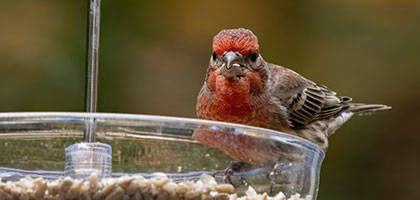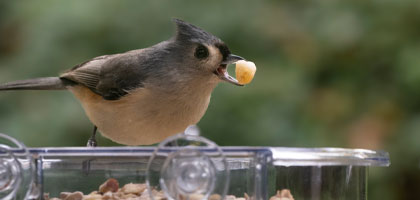Bird watching is a rewarding hobby. It brings us closer to nature and provides a sense of tranquility.
But what if the birds aren't coming to your garden?
You've bought a new bird feeder, filled it with seeds, but the birds seem to ignore it. This can be frustrating, especially when you're eager to observe these feathered friends up close.
Don't worry.
This guide will provide practical tips on how to help birds find your new bird feeder. We'll discuss the importance of feeder types, placement, and maintenance, among other things.
By the end of this article, you'll be well-equipped to attract a variety of birds to your garden. Let's get started.
Understanding Your Avian Visitors
Before setting up a bird feeder, it's essential to know which birds frequent your area. Observing local bird species helps in choosing the right feeder and seed.
Different birds have unique preferences and feeding habits. Some prefer eating from elevated spots, while others forage on the ground. Researching local bird species can provide invaluable insights into these behaviors.
Consider peak bird-watching seasons, as some species migrate and may only appear at certain times of the year. Catering to these patterns can maximize your chances of attracting various birds.
By understanding your avian visitors, you can tailor your feeding approach. This targeted strategy enhances the chances of your feeder becoming a popular spot for birds.
Selecting the Right Bird Feeder Types
Choosing the right bird feeder is crucial. Each type attracts different species based on their feeding habits. It's wise to diversify the feeders in your yard to welcome a variety of birds.
Here's a list of popular bird feeder types to consider:
-
Platform feeders: These open feeders cater to ground-feeding birds, allowing easy access to all birds.
-
House or hopper feeders: These feeders are weather-protected and store more seed, attracting larger birds like cardinals.
-
Tube feeders: Best for small birds, tube feeders feature multiple feeding ports and discourage larger birds and pests.
-
Nyjer or thistle feeders: These are ideal for finches, designed with tiny holes to dispense small seeds.
-
Suet feeders: Made for clinging birds like woodpeckers, suet feeders provide high-energy fat.
-
Specialty feeders (e.g., fruit, mealworm): These feeders cater to more specific bird diets, attracting diverse species like orioles and bluebirds.
Selecting diverse feeders ensures all types of birds find something they like. It allows you to see a wide array of bird species in your garden.
Best Placement for Maximum Visibility
Finding the ideal spot for your bird feeder is vital. Birds need to feel safe and see the feeder from afar. Avoid placing feeders too close to your house to reduce bird collisions with windows.
Select a location with good visibility, sheltered from strong winds. Consider placing feeders near natural cover like bushes or trees. This provides birds an escape route from predators.
Ensure the feeder is in view, but not in direct, harsh sunlight all day. It should be accessible but slightly concealed to protect against predators.
Remember to monitor the area regularly. Adjust placement if birds aren't visiting as expected. This may help improve visibility and accessibility for your feathered visitors.
The Importance of Quality Birdseed
Choosing the right birdseed can greatly affect which birds visit your feeder. Different species have unique dietary needs. Offering a variety ensures a broad range of birds will stop by.
High-quality birdseed is key to attracting and nourishing birds. Opt for seed blends that cater to the birds native to your area. This will prevent waste and make your feeder more appealing.
Avoid fillers like milo and wheat in seed mixes. Birds often discard these, which can create messes and attract unwanted pests. Instead, choose seeds like sunflower and nyjer favored by many species.
Proper storage of birdseed is crucial to maintain its freshness. Keep your birdseed in a cool, dry place, and ensure the container is rodent-proof. Fresh seed will help keep your avian visitors healthy and satisfied.
Creating a Bird-Friendly Habitat
To attract a variety of birds, it's essential to create a welcoming environment. A bird-friendly habitat includes native plants that offer both shelter and food. These plants can also provide nesting opportunities.
Water sources like bird baths or small ponds are great attractors. Birds not only need water for drinking but also for bathing. Ensure the water is fresh and not too deep for small birds.
Landscaping with layers is effective for inviting birds. Different heights of vegetation cater to different species' preferences. Taller trees, medium shrubs, and low plants provide diverse options for birds.
Natural elements such as rocks, logs, or brush piles add to the appeal. These features mimic natural habitats and offer hideouts from predators. By making small changes, your outdoor space can become a haven for many bird species.
Maintenance and Cleanliness of Feeders
Keeping bird feeders clean is crucial for bird health. Dirty feeders can harbor harmful bacteria. Regularly wash feeders with a mild soap solution.
Ensure feeders are fully dry before refilling them with birdseed. Moisture can lead to mold growth, which is unhealthy for birds. Cleaning should be done at least every two weeks.
Check for damage or wear frequently. Cracks in feeders can trap moisture and spoil food. Repair or replace damaged parts to maintain a safe feeding environment.
Dispose of old or wet birdseed promptly. Spoiled seed can deter birds and encourage pests. Maintaining clean feeders ensures a healthy feeding space for your feathered visitors.
DIY Bird Feeders: Personal Touches to Attract Feathered Friends
Creating DIY bird feeders can be a fulfilling activity. Using simple materials, you can craft feeders that suit your garden's aesthetic. The benefits extend to both you and visiting birds.
Recycled materials like plastic bottles or milk cartons are great options. Transforming these materials keeps costs low and makes the project environmentally friendly. Birds aren't picky about fashion, just function.
Personalizing your feeder can add charm. Paint them in bright colors to attract specific bird species. Just ensure the paint is non-toxic to keep the feeders bird-safe.
Involving family members in a DIY project can be a fun bonding experience. It also fosters an appreciation for wildlife. Engaging in these activities helps create a welcoming environment for birds in your backyard.
Patience and Consistency: The Key to Success
Patience is essential when introducing a new bird feeder. Birds might not immediately recognize the new addition. It can take time for them to discover and get comfortable using it.
Consistency in feeding schedules can help build bird trust. Birds learn to expect food at certain times and will visit more regularly. Regularly refilling the feeder shows birds that it's a reliable food source.
Monitoring bird activity can inform necessary adjustments. If birds aren't visiting, try moving the feeder slightly or changing the seed type. Sometimes small tweaks can make a big difference.
Finally, remember that birds need time to form habits. Your steady efforts will be rewarded as birds gradually become regular visitors. Enjoy each small progress and cherish the moments of observing these feathered friends.
Conclusion: Enjoying Your New Avian Friends
Watching birds flock to your feeder can be a delightful experience. It's a rewarding culmination of your efforts to create a welcoming space. Birdwatching can provide relaxation and a sense of connection with nature.
As you spend time observing, you'll learn about the habits and behaviors of various bird species. This knowledge can enhance your feeding strategies and the enjoyment of your hobby. Each species brings its unique charm and beauty to your garden.
Share your experience with family and friends to foster their appreciation of birds. You could also join online bird-watching groups to exchange tips and stories. Engaging with a community adds another layer of fulfillment.
Continue experimenting with different feeder types and seeds to attract new species. Bird-feeding can be a lifelong journey of learning and discovery. As you nurture your avian friends, take joy in the vibrant life they bring to your outdoor space.




